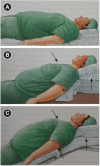Anesthetic management of obese and morbidly obese parturients
- PMID: 35139612
- PMCID: PMC8828627
- DOI: 10.17085/apm.21090
Anesthetic management of obese and morbidly obese parturients
Abstract
The prevalence of obese parturients is increasing worldwide. This review describes safe analgesic techniques for labor and anesthetic management during cesarean sections in obese parturients. The epidural analgesic technique is the best way to provide good pain relief during the labor phase and can be easily converted to a surgical anesthetic condition. However, the insertion of the epidural catheter in obese parturients is technically more difficult compared to that in non-obese parturients. The distance from the skin to the epidural space increases in proportion to the body mass index (BMI): 4.4 cm in mothers of normal weight and 7.5 cm in mothers with BMI 50 and above. Neuraxial blocks are the ideal anesthetic methods and gold standard techniques for cesarean section in pregnant women with obesity. Single-shot spinal anesthesia is the most common type of anesthesia used for cesarean sections. The advantage of single-shot spinal anesthesia is a dense-sufficient block of rapid onset. A combined spinal-epidural (CSE) anesthetic technique is also recommended as an attractive alternative method. In obese parturients, the operation time can be longer than expected, and therefore, the CSE technique provides the advantage of rapid onset and intense block for prolonged operation with postoperative pain control. The risk of postoperative complications is very high in obese parturients. Therefore, detailed communication of the parturient's medical condition and the details of surgery and anesthesia between the anesthesiologist and obstetrician is important prior to cesarean section in obese pregnant women.
Keywords: Analgesia; Anesthesia; Morbid obesity; Pregnancy.
Conflict of interest statement
No potential conflict of interest relevant to this article was reported.
Figures

Similar articles
-
Anesthetic and obstetric outcome in morbidly obese parturients.Anesthesiology. 1993 Dec;79(6):1210-8. doi: 10.1097/00000542-199312000-00011. Anesthesiology. 1993. PMID: 8267196
-
Anesthetic and obstetric outcomes in morbidly obese parturients: a 20-year follow-up retrospective cohort study.Int J Obstet Anesth. 2014 Nov;23(4):357-64. doi: 10.1016/j.ijoa.2014.05.004. Epub 2014 Jun 4. Int J Obstet Anesth. 2014. PMID: 25201313
-
Anesthetic management of super-morbidly obese parturients for cesarean delivery with a double neuraxial catheter technique: a case series.Int J Obstet Anesth. 2015 Aug;24(3):276-80. doi: 10.1016/j.ijoa.2015.04.001. Epub 2015 Apr 8. Int J Obstet Anesth. 2015. PMID: 25936783
-
Managing anesthesia for cesarean section in obese patients: current perspectives.Local Reg Anesth. 2016 Aug 16;9:45-57. doi: 10.2147/LRA.S64279. eCollection 2016. Local Reg Anesth. 2016. PMID: 27574464 Free PMC article. Review.
-
Obesity And Obstetric Anesthesia: Current Insights.Local Reg Anesth. 2019 Nov 18;12:111-124. doi: 10.2147/LRA.S186530. eCollection 2019. Local Reg Anesth. 2019. PMID: 31819609 Free PMC article. Review.
Cited by
-
Body mass index and benign breast surgeries: A survey of plastic surgeons' knowledge and attitudes.JPRAS Open. 2023 Feb 9;36:46-54. doi: 10.1016/j.jpra.2023.02.001. eCollection 2023 Jun. JPRAS Open. 2023. PMID: 37102187 Free PMC article.
-
Artificial intelligence enhanced ultrasound (AI-US) in a severe obese parturient: a case report.Ultrasound J. 2022 Aug 3;14(1):34. doi: 10.1186/s13089-022-00283-5. Ultrasound J. 2022. PMID: 35920947 Free PMC article.
-
Comparison of Spinal Morphine and Transversus Abdominis Plane Block on Opioid Requirements After Caesarean Section: An Observational Study.Local Reg Anesth. 2024 Jun 12;17:79-86. doi: 10.2147/LRA.S459530. eCollection 2024. Local Reg Anesth. 2024. PMID: 38883999 Free PMC article.
-
Spinal Anesthesia for Cesarean Section in a Class III Obese Parturient: A Case Report.Cureus. 2025 Apr 29;17(4):e83214. doi: 10.7759/cureus.83214. eCollection 2025 Apr. Cureus. 2025. PMID: 40443599 Free PMC article.
References
-
- KOSIS. The trend in the prevalence of obesity (BMI). Statistics Korea [serial on the Internet]. [2021 May 20]. Available from https://kosis.kr/statHtml/statHtml.do?orgId=177&tblId=DT_11702_N101&conn....
-
- Obesity: preventing and managing the global epidemic. Report of a WHO consultation. World Health Organ Tech Rep Ser. 2000;894:i–xii, 1. - PubMed
-
- Jee SH, Sull JW, Park J, Lee SY, Ohrr H, Guallar E, et al. Body-mass index and mortality in Korean men and women. N Engl J Med. 2006;355:779–87. - PubMed
-
- Institute of Medicine (US) Committee on Nutritional Status during Pregnancy and Lactation. Nutrition during pregnancy: part I weight gain: part II nutrient supplements. Washington D.C., National Academies Press (US). 1990, pp 5-10. - PubMed
-
- WHO Expert Consultation. Appropriate body-mass index for Asian populations and its implications for policy and intervention strategies. Lancet. 2004;363:157–63. - PubMed
Publication types
LinkOut - more resources
Full Text Sources
Medical

